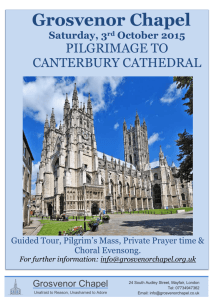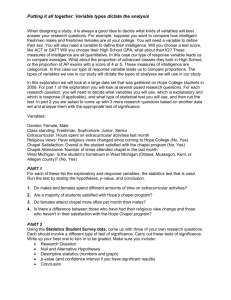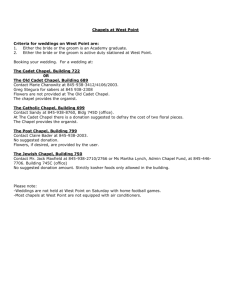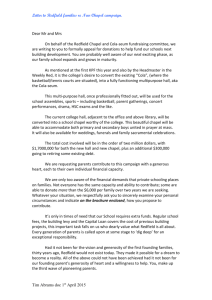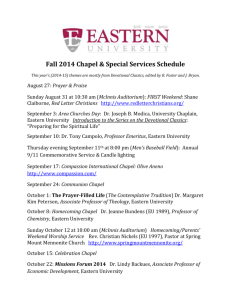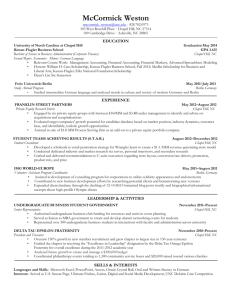Chapel tour brochure - Texas Woman`s University
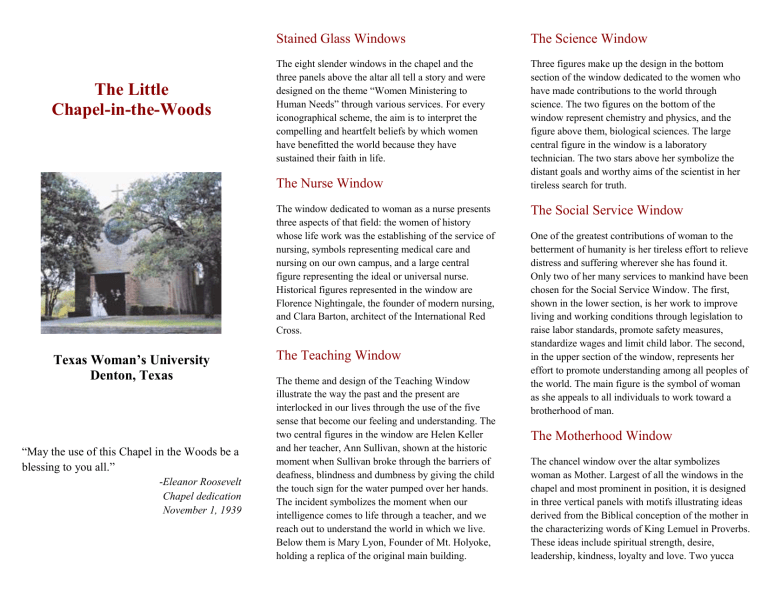
The Little
Chapel-in-the-Woods
Texas Woman’s University
Denton, Texas
“May the use of this Chapel in the Woods be a blessing to you all.”
Eleanor Roosevelt
Chapel dedication
November 1, 1939
Stained Glass Windows
The eight slender windows in the chapel and the three panels above the altar all tell a story and were designed on the theme “Women Ministering to
Human Needs” through various services. For every iconographical scheme, the aim is to interpret the compelling and heartfelt beliefs by which women have benefitted the world because they have sustained their faith in life.
The Nurse Window
The window dedicated to woman as a nurse presents three aspects of that field: the women of history whose life work was the establishing of the service of nursing, symbols representing medical care and nursing on our own campus, and a large central figure representing the ideal or universal nurse.
Historical figures represented in the window are
Florence Nightingale, the founder of modern nursing, and Clara Barton, architect of the International Red
Cross.
The Teaching Window
The theme and design of the Teaching Window illustrate the way the past and the present are interlocked in our lives through the use of the five sense that become our feeling and understanding. The two central figures in the window are Helen Keller and her teacher, Ann Sullivan, shown at the historic moment when Sullivan broke through the barriers of deafness, blindness and dumbness by giving the child the touch sign for the water pumped over her hands.
The incident symbolizes the moment when our intelligence comes to life through a teacher, and we reach out to understand the world in which we live.
Below them is Mary Lyon, Founder of Mt. Holyoke, holding a replica of the original main building.
The Science Window
Three figures make up the design in the bottom section of the window dedicated to the women who have made contributions to the world through science. The two figures on the bottom of the window represent chemistry and physics, and the figure above them, biological sciences. The large central figure in the window is a laboratory technician. The two stars above her symbolize the distant goals and worthy aims of the scientist in her tireless search for truth.
The Social Service Window
One of the greatest contributions of woman to the betterment of humanity is her tireless effort to relieve distress and suffering wherever she has found it.
Only two of her many services to mankind have been chosen for the Social Service Window. The first, shown in the lower section, is her work to improve living and working conditions through legislation to raise labor standards, promote safety measures, standardize wages and limit child labor. The second, in the upper section of the window, represents her effort to promote understanding among all peoples of the world. The main figure is the symbol of woman as she appeals to all individuals to work toward a brotherhood of man.
The Motherhood Window
The chancel window over the altar symbolizes woman as Mother. Largest of all the windows in the chapel and most prominent in position, it is designed in three vertical panels with motifs illustrating ideas derived from the Biblical conception of the mother in the characterizing words of King Lemuel in Proverbs.
These ideas include spiritual strength, desire, leadership, kindness, loyalty and love. Two yucca
borders extend from base to top on either side of the large figures in the Motherhood Window. They symbolize vitality of heart and mind, and resilience of spirit in women, qualities suggested by the plant.
The Music Window
“
Gloria in Excelsis Deo
” is the inscription at the base of the window dedicated to woman and her achievement through music. The organist, the mother singing a lullaby to her child, the choirs, the girls playing cello, horn and violin, and the girl singing in an operatic role suggest the great variety of ways by which women express themselves through music. In contrast to the smaller figures is the large soloist who also wears a robe. She represents the trained singer whose talent is great enough to identify her as a woman who ministers to the aesthetic needs of the world through music.
The Dance Window
The Dance Window presents woman as she has followed her desire to find an expression of beauty through movement. The historical figures presented in the Dance Window are those whose work was responsible for the development of the ideals of modern dance. The first of these is Isadora Duncan surrounded by figures representing the more formal and conservative forms of dance against which she rebelled. The second is Ruth St. Denis, whose work as a teacher is responsible for many present day dancers. The large central figure symbolizes the ideals of modern dance in unhampered and unconcealed movements.
The Literature Window
To represent all women poets, a quotation from the profound and ethical teachings of George Elliot was chosen for the inscription on this window. The figures standing beside and above the inscription symbolize, respectively, Lyric, Epic and Dramatic poetry. Beside these are three masks whose expressions convey Wit, Satire and Humor. The large central figure is Literature holding a page of her manuscript.
The Speech Window
The Speech Window presents an embodiment of three divisions of the speech arts: the Drama, the
Spoken Word for entertainment and instruction, and
Speech as communication. The standing figure at the bottom of the window represents the great renaissance actress Isabella Andreini and the women whose dramatic ability has been used to interpret comic and tragic roles. The large central figure was designed to represent speech with the open Book of
Interpretation as a symbol of the beauty women can reveal to the world through everyday speech.
The Rose Window
The Rose Window is an abstraction reflecting woman’s joy in the physical world around her.
Typically bright and vivid colors of the Southwest, together with native flower forms, are chosen to convey this mood and feeling. An image of this window was used as the focal point on the cover of the current Brides’ Book because, after stating their vows, it is the first sight the couple witness as they leave the chapel to begin their life anew.
The Signature Window
This small window in the vestibule shows the builders, donors, and decorators of the chapel in characteristic pose. Beginning at the lower left corner, the window reads up as follows: President
Hubbard envisions the chapel as Mr. and Mrs.
Nicholson, Molly Simpson, and Miss Elida M.
Pearson offer donations. Above them are the architects, O’Neil Ford and A.B. Swank, along with
Preston Geren and the Chapel Committee, Miss
Jessie H. Humphries, Holford S. Russell, Marvin
Loveless, William E. Jones, Dorothy LaSelle, and Dr.
Constance Beach. Above them are the NYA foreman,
Mr. Hodges, and three NYA boys. Above them are several of other contributors to work on the chapel:
Adeline Lee, Dorothy LaSelle, Carmeta Drummond,
Sammy Tate, Billie Marie Culwell and Helen
Solberg. In the left border is the stained glass crew:
Marilyn Yates, Lucille Cudd, Mary Anne Chaddick,
Ivy May Chollar, Billie Marie Culwell, Helen Crain,
Betty Winston, Nora Mae Pierce, Mary Cook and
Beatrice Paschall.
Office of Conference Services
Texas Woman’s University
P.O. Box 425379
Denton, TX 76204
940-898-3644
Littlechapel@mail.twu.edu


